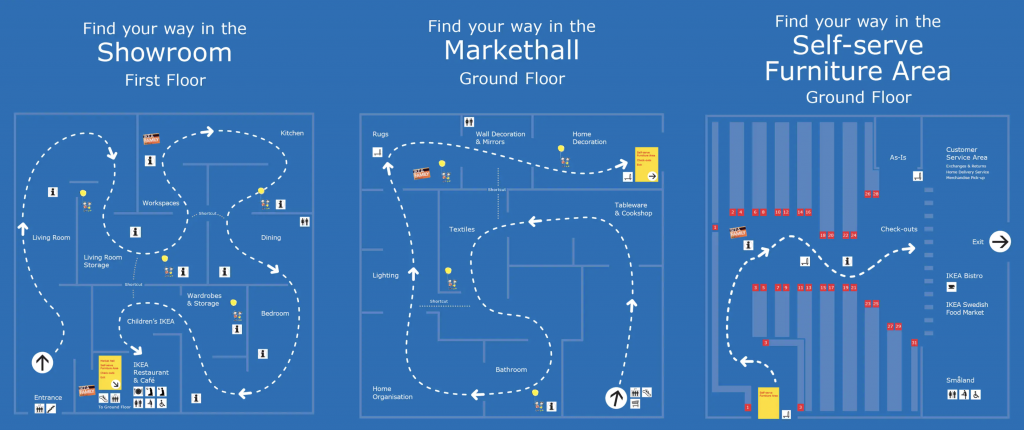Have you ever walked through an Ikea? Maybe a bad analogy because while we all love Ikea, we all hate the intentionally shitty wayfinding maze that Ikea experience is.
I’m creating a content audit + ongoing recommendations service. It’s an iterative process with new capabilities being added almost weekly. If you’re interested, hit reply and let’s discuss.
They have a very specific path they want you to follow: living room > related storage > workspaces > kitchen > dining > bedroom > related storage > childrens area > food court > decor > self-service warehouse

On the path though, they provide little shortcut side exits to skip areas that might be unrelated to your needs.
They put the food court at the halfway point because they can’t upsell you on decor when you’re starving.
They put a cut through to the kid’s area early, because they know kids have even less patience than the rest of us.
It’s all very clever and grounded in their desire to sell you things in the context of understanding of you as a consumer and how your state of mind changes over the course of the experience of buying literally anything from Ikea in store.
But experts with content often either ignore the more commercial activities we should be engaged in or let them detract from how we should be thinking about users.
The trick is to strike a balance, to find where user problem maps naturally to expert solution.
When users come across a page on your site through search, they are in a mode of thinking in terms of pointy concrete problems or imagined more abstract outcomes. Something like:
- skills – eg. beginner – intermediate – advanced
- stages – eg. startup – growth – stability
- problem – eg. identifying > understanding > solving
We, on the other hand, think (or don’t!) in terms of models like:
- Top > middle > bottom of funnel content
- Traffic > subscriptions > sales
- Awareness > interest > desire > action (AIDA)
Similar but it’s easy to miss each other, which I wrote a bit about yesterday.
I’ll hear prospects say things like, “I think I need a better funnel.” “I just want more traffic.”
Meanwhile, I’ll want to write about content recommendation algorithms. It’s a meaningful consideration for improving funnels and traffic at some scale, but no one wants to read about it.
The user wanting a better funnel or more traffic might start by Googling for marketing funnel tools or how to get more traffic to their blog.
Assumptions, biases, and preferences guide further searches on the journey.
If you read a post that recommends link outreach and writing longer posts, and you’re averse to outreach, you’ll likely ignore the outreach advice and opt for writing longer posts.
Users inevitably latch on to what feels the most comfortable and makes the most sense to them.
It’s our responsibility to show these users the well-worn path to where they want to go, given their constraints and preferences.
Follow the user journey chain
Most everyone I talk to about their site content can pull out two to three distinct groups that consume their content which would be a significant improvement on what they’re currently doing.
There are two common breakdown patterns here:
- multiple audience segments, where the audience groups are distinct, but the problem areas overlap
- distinct phases of a user’s evolution, which was represented above:
- skill level
- growth stage
- problem solving
An expert on dealing with sociopaths/narcissists in relationships may identify three problem areas common among their users:
- understanding whether you’re in a relationships with one
- leaving / divorcing one
- recovering from the trauma of that experience
These are three phases victims might go through to achieve an outcome of life after a very specific kind of abusive relationship.
But often the mindsets of identifying a problem and escaping that problem are a world apart. And with problem-solution matrices of each being so distinct and nuanced, your best option is to categorize them separately.
You can break content into three buckets that serve those groups as distinct and still allow for the Ikea style shortcuts to pre-learn about what comes next or review what they might have missed.
Top-level navigation provides good starting points.
Supplemental navigation provides a way for users to move between content groupings, to connect the dots in the context of your expressed expertise.
Users appreciate it because they get to quickly determine if you “get” their problem and browse a buffet of your best related content.
You get to show them you have something to offer, something you made for them.
Google gets to connect the dots more clearly as well. Your top-level groupings are now easier to identify: related content and topics are linked together. This makes signaling what’s important directly to Google. And as you’re elevating your best content, it makes it easier for others to find, share, discuss, and link to that best content.
Win-win-win.
